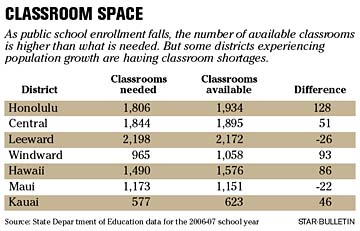Many isle schools face space crunch
Statewide capacity is adequate, but some facilities fall short
STORY SUMMARY »
Classrooms across the state are increasingly being used for storage, office space or special programs as public school enrollment continues to drop, but campuses near sprawling neighborhoods are getting crowded, with several schools short 10 or more classrooms.
There were 10,408 classrooms among Hawaii's 286 public schools in the recently completed academic year -- 356 more than what is needed to teach the current student body, according to the state Department of Education.
Farrington and Waianae high schools have the most critical shortage, with each lacking 16 classrooms. Meanwhile, Kailua Intermediate has 54 classrooms -- 18 more than it needs, and Mililani Middle has 102, a surplus of 16.

To deal with the crunch, principals are splitting classrooms, adding portables and having instructors share office space and teach multiple subjects. Those in schools with classroom surpluses say the additional space is not overkill and allows them to designate rooms for a variety of student services and programs.
The Department of Education asked the Legislature this spring for $286 million for 63 extra classrooms and four new schools statewide. Lawmakers, however, approved funding for only two of the schools.
FULL STORY »

JAMM AQUINO / JAQUINO@STARBULLETIN.COM
Sybil Hamada taught special-motivation English students at Farrington High School yesterday in a classroom that has been partitioned to maximize space.
|
|
Some public schools are splitting up rooms, lecturing students under trees and having instructors share office space and teach more than one subject to deal with classroom shortages.
"We are tight. We do have space for people but it's very tight," said Richard Paul, principal of Hana High and Elementary School on Maui, which is four rooms short.
Scores of campuses in Hawaii, mostly on Maui and in Leeward Oahu, are lacking classrooms despite an overall fall in enrollment that has created a space surplus in the state. Principals are attributing the crunch in large part to an influx of special needs students and those with English as a second language who require larger classrooms and more supervision.
At Farrington High, the number of special education students has grown to 300 from 190 in 1995, said Principal Catherine Payne. School officials recently kicked out an on-campus childcare center for teens who had babies because they needed its two classrooms.
"We've had to expand room space for them and we certainly can't move those children around the school," she said. "We have just taken over other classrooms."
At Hana High, counselors take up entire classrooms to be alone with students, Paul said.
"You can't stick two of those counselors in the same space," he said, "and we don't have a bunch of little confidential spaces."
To make up for the lost space, some teachers are sharing classrooms or taking on more than one subject, Paul said. He said the school should have "lots of breathing room" with a new, six-classroom building expected to be ready in January.
At Leilehua High, where enrollment has reached 1,900, classrooms are being divided in half while some teachers are integrating students from different classes into one, said Vice Principal Bob Davis. The school, which is short 14 classrooms even after adding five portables and getting a two-story building, is waiting for three more temporary classes, he said.
A state Department of Education study found there were 10,408 classrooms among 286 public schools at the end of the 2006-07 school year -- 356 more than what is needed to teach the current student body. The surplus comes as enrollment for the 2007-08 year is expected to drop a bit from last year's count of 179,234.
Benjamin Parker School is listed as having 14 additional classrooms for 330 K-6 students, but Vice Principal Arlene Medeiros said all rooms are being used by tutors or to house special programs. "We are kind of lucky in that sense," she said. "It's not like we are teaching out of closets or storage rooms, like it has been in the past."
Education officials asked the Legislature this spring for $286 million for 63 extra classrooms and four new schools statewide, but lawmakers approved funding for only two of the schools, Ewa Makai Middle School and Wailuku II Elementary, said Sanford Beppo, capital improvement planner in the Facilities Development Branch.
A Board of Education committee is studying the classroom disparity issue and looking at relocation of rented office space to schools, creation of specialty schools and revision of policies to consolidate nearby schools with declining enrollment.
"We are painfully aware that there are certain areas in the state that have excess capacity and that others are under capacity, overcrowding schools," said board member Breene Harimoto, who chairs the committee.
The Education Department has been easing the scarcity of classrooms by buying portables, which now number 1,600 in Hawaii, Beppo said.

